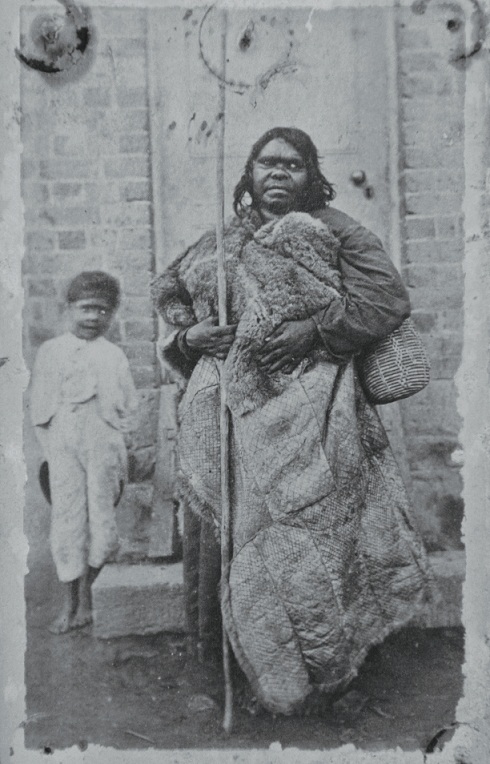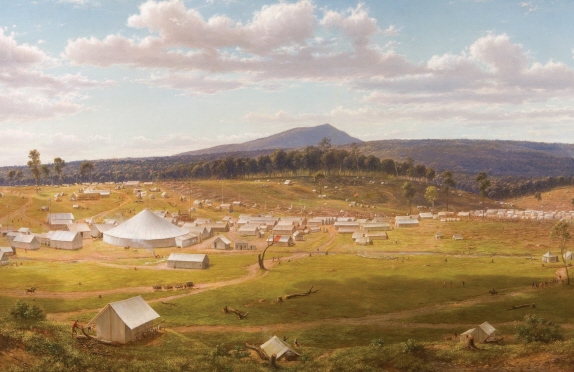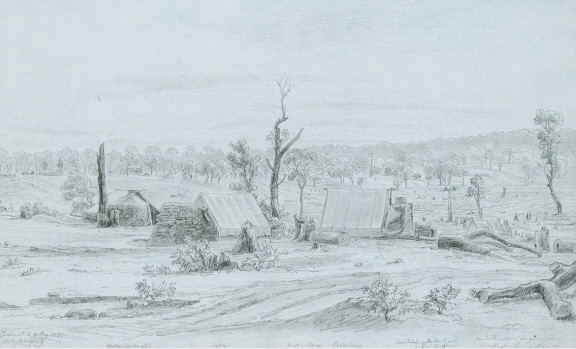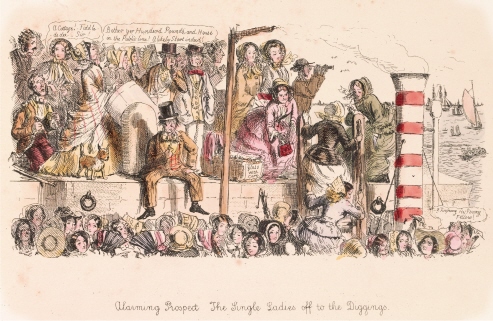The Forgotten Rebels of Eureka (19 page)
Read The Forgotten Rebels of Eureka Online
Authors: Clare Wright
Tags: #HIS004000, #HIS054000, #HIS031000

Such unharnessed emotion would later fuel a tragedy, but for now Mrs Massey felt joyfully off the leash. What had initially settled upon her as a black cloud of submissive misery now seemed like
a party of pleasure
. True to her creed of feminine adaptation, Mrs Massey marvelled at the sights along the road: the gigantic fallen gums, the sweet-scented wattles and correas, a
fairyland
of magnificent new flowers to behold. She and other (unidentified) female travelling companions camped for the night in the Black Forest, sleeping under the cart with their cloaks used to make a barricade against a looming storm. Mrs Massey revelled in the
sweet harmony of nature
. Every new thunderclap or lightning strike sent waves of electricity down her straitlaced back.
All is romance in this most romantic land
, she sighed.
Some women initially believed, like Elizabeth Massey, they were on the road to perdition but happily discovered they were actually on a path to unexpected release. Others yearned to be let loose and saw a journey to the goldfields as a credible flight path. Historians have long commented on the escape fantasies that, more than simple gold lust, stimulated men's rush to the diggings.
â¦[in] the days when men broke their bonds and dreamed of marvellous things to come.
It's always been at least implicitâsometimes aggressively obviousâthat among the bonds from which men longed to be free were the harping women with their insufferable demands and bawling brats. There is no doubt that some men did see the goldfields as their ticket out of a domestic rut. Square this fact with all the late-nineteenth-century jingoism about frontier independence, and we have deadbeats like Janet Kincaid's husband reincarnated as national heroes.
But it's clear that many women also harboured their own aspirations of escape, not necessarily from spouses and children, but from the tedious and restrictive rituals of the feminine daily round. In particular, many educated and refined women (in the words of one emigrant who eloped with her brother's tutor and emigrated to Victoria)
thought the ease of their English life well left behind them
. High teas and calling cards were a subtle form of foot binding for many nineteenth-century British gentlewomen. The price of material comfort was conformity: it cost a lot of effort and anxiety to keep up appearances. Years later, Mrs Massey, who spent two years on the diggings between 1852 and 1854, would write
I look back with a grateful heart to my gipsy life
. But of course it is the women who disappeared into the slipstream of the nomadsâthe ones who didn't record their thoughts or movements for a reading audienceâwho truly abandoned genteel performance and enjoyed the colonial gift of insignificance.

Refugees from convention were joined on the road by fugitives from the law. The goldfields frontier offered rabbit warrens of protection for women who needed a fresh start. The predominance of ex-convicts from Van Diemen's Land on the goldfields became a political issue after 1853, but local currency lasses could also find themselves in trouble. Chief among such miscreants were âfallen women', those who had drawn the short straw in the lottery of premarital sex. A Miss Smith, with her fatherless baby, could be reincarnated on the diggings as Mrs Smith, an apocryphal widow who'd lost her husband in a mining accident or maritime mishap.
For it was no joke to be âcaught out'. Reports of young women who killed or abandoned their newborns in an attempt to hide the evidence of sin are common. On 31 October 1854, for example, the colonial secretary was informed that a one-month-old child had been found in the grounds of St John's School on the corner of Elizabeth and La Trobe streets in Melbourne. The babe,
who was in good health
, was wearing a long white frock, white cap and white flannel hood and was wrapped in a blue and green checked shawl. The
GOVERNMENT GAZETTE
posted a reward for the apprehension of the mother.
The
POLICE GAZETTE
was also replete with reports of female runaways. On 27 February 1854, information was distributed about one Sarah Wilson, who had left the hired service of Mr Smith in Collingwood before the expiry of her contract. Wilson was nineteen years old, slightly under five foot, with a dark complexion and small, regular features.
She has left her clothes behind her and has no relatives in Melbourne
, noted the
GAZETTE
. In March 1854, Ann Plummer escaped from the residence of her husband in Fitzroy Crescent. Ann had been tried for an undisclosed offence at the Central Criminal Court in 1849 and given a fifteen-year sentence, to be served at the premises of her husband. Ann was described as aged twenty-five years, a fancy-box maker, five foot one inch tall, with a
fresh complexion, brown hair, blue eyes, native Burnley, nose has been smashed
.
21
Women had many pragmatic reasons to seek the anarchic embrace of the goldfields.
For Catherine Sherwin, Ballarat would be the place to build a dynasty from ignominious beginnings. Literate and ambitious, Catherine and her sister Mary had sailed to Australia as free immigrants in 1850. At five foot one, of slight build with a dark complexion, black hair and grey eyes, Catherine would have had some capital in the colonial marriage market. If the Sherwins followed typical patterns of Irish family chain migration, it's possible that Catherine's elder brothers came to Victoria first, followed by the unmarried sisters and finally the parents, with younger siblings in tow. There were certainly other Sherwins residing in Victoria, with whom Catherine later regrouped when her life course was derailed.
Like other Irish immigrant girls of the Famine generation, Catherine and Mary married soon after their arrival in the colony. Catherine was witness at Mary's wedding to Everard Gadd at the Wesleyan Methodist Church in Melbourne in April 1852. Five months later, Catherine exchanged her vows with James Francis Bentley at St Peter's Anglican Church. James was a thirty-four-year-old native of Surrey, England, running a confectionery business in Elizabeth Street, North Melbourne. Thirteen years her elder, James had experienced far more of colonial life than his young bride, not least because he had been transported to Norfolk Island on a ten-year sentence in 1844.
Of average height and stoutly built, with dark hair, a fair complexion, a mole on the back of his neck and a slight limp caused by a mutilated right foot, James nonetheless caught Catherine's eye. According to family oral history, the couple married for love.
22
In 1852, newly wedded to a merchant with good connections in Melbourne societyâand pregnant within a few months of her marriageâCatherine's colonial star was only rising. Her first son, Francis Henry Bentley, known throughout his life as Thomas, was born in September 1853 in his parents' shop. Shortly after her confinement, Catherine and her young family were on the road.

The summer of 1853 brought the predictable fusion of heat, dust and savage episodes of scorching wind. Flies crawled through meat carcasses and into wet, sticky human orifices. Colonial typhus menaced the goldfields populace, just as it did Melbourne's, with its low fever and high mortality rate. Dysentery was another quiet killer, especially of babies. Rumblings of discontent vibrated beneath the seemingly solid foundations of a tent city built on gold. Christmas was almost here, bringing its celebration of birth, its hope for renewal and its inevitable focus on those who were not invited into the stable.
For the imminent Yuletide revelry, Frances Pierson decided to combat homesickness with generosity.
Frances is well and
stands it here first rate
, wrote Thomas, with a touch of incredulity that his wife had managed to make such a smooth transition to a suntan in December. She had recently purchased a Yankee cooking stove from Melbourne for £8 plus £3 cartage, benefiting from the economical summer transport costs. She baked a load of apple pies, cranberry tarts and sweet cakes. Enough for her small family to enjoy, and to share with some of the many single diggers who would be celebrating the festive season devoid of mothers, sisters and home comforts. Perhaps she would even sell some of her precious wares. Lord knew they could use the extra shillings.
On Christmas Day 1853, Thomas Pierson cast a glance at his robust wife, stoking the campfire, and his teenage son, skylarking with a crew of new mates. Surprised by his own high spirits, he wrote in his diary:
Well here we are on the Ballarat diggings. The question naturally occurs: where will we all be the next Christmas of '54?

Queen Rose of the Wathaurung people in her possumskin cloak, 1876.

Old Ballarat as it was in the summer of 1853â54: the golden vision that Eugene von Guérard painted in 1884.

One of von Guérard's more realistic sketches of Ballarat, from 1854.
